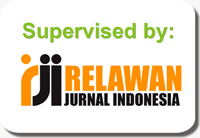Signature Identification using Digital Image Processing and Machine Learning Methods
DOI:
https://doi.org/10.31961/eltikom.v7i1.618Keywords:
HOG, KNN, Naive bayes, Signature, SVMAbstract
Signature is used to legally approve an agreement, treaty, and state administrative activities. Identification of the signature is required to ensure ownership of a signature and to prevent things like forgery from happening to the owner of the signature. In this study, data signatures were obtained from 25 people over the age of 50. The signers provided 20 signatures and were free to choose the stationery used to write the signature on white paper. The total data obtained in this study was 500 signature data. The obtained signature was scanned to create a signature image, which was then pre-processed to prepare it for feature extraction, which can characterize the signature images. The HOG method was used to extract features, resulting in a dataset with 4,536 feature vectors for each signature image. To identify the signature image, the classification methods SVM, Decision Tree, Nave Bayes, and K-NN were compared. SVM achieved the highest accuracy, which is 100%. When K=5, the K-NN method achieved a fairly good accuracy of 97.3%. Meanwhile, Naive Bayes and Decision Tree achieved accuracy significantly lower than K-NN (61%). Because the HOG method produced a large feature vector for each signature, it is recommended that important features that represent signatures be optimized or extracted to produce smaller features to speed up computation without sacrificing accuracy, and that the HOG method be compared to other extraction feature methods to obtain a better model in future research.
Downloads
References
B. C. Octariadi, “Pengenalan Pola Tanda Tangan Menggunakan Metode Jaringan Syaraf Tiruan Backpropagation,†J. Teknoinfo, vol. 14, no. 1, pp. 15–21, 2020.
G. Novandra, M. Z. Nafâ, and T. G. Laksana, “Perancangan aplikasi android identifikasi tanda tangan menggunakan multi layer perceptron,†JIPI (Jurnal Ilm. Penelit. dan Pembelajaran Inform., vol. 3, no. 1, 2018.
J. Arifin and M. Z. Naf’an, “Verifikasi Tanda Tangan Asli Atau Palsu Berdasarkan Sifat Keacakan (Entropi),†J. Infotel, vol. 9, no. 1, pp. 130–135, 2017.
M. S. Simanjuntak, R. Rosnelly, and W. Wanayumini, “Identifikasi Tanda Tangan menggunakan Metode Fitur Ekstrasi Biner dan K Nearest Neighbor,†CSRID (Computer Sci. Res. Its Dev. Journal), vol. 12, no. 3, pp. 191–200, 2021.
W. Fitriani, M. Z. Naf’an, and E. Usada, “Ekstraksi Fitur pada Citra Tanda Tangan Sebagai Ciri Identitas Pemiliknya Menggunakan Discrete Fourier Transform,†2018.
A. Afrizal, “Permasalahan Yang Dialami Lansia Dalam Menyesuaikan Diri Terhadap Penguasaan Tugas-Tugas Perkembangannya,†Islam. Couns. J. Bimbing. dan Konseling Islam, vol. 2, no. 2, pp. 91–106, 2018.
P. Mudjirahardjo and A. Basuki, “Identifikasi Tanda Tangan dengan Ekstraksi Ciri GLCM dan LBP,†J. EECCIS (Electrics, Electron. Commun. Control. Informatics, Syst., vol. 13, no. 1, pp. 6–10, 2019.
A. Hidayatno, R. R. Isnanto, and D. K. W. Buana, “Identifikasi Tanda-Tangan Menggunakan Jaringan Saraf Tiruan Perambatan-Balik (Backpropagation),†J. Teknol., vol. 1, no. 2, pp. 100–106, 2008.
M. Taşkiran and Z. G. Çam, “Offline signature identification via HOG features and artificial neural networks,†in 2017 IEEE 15th International Symposium on Applied Machine Intelligence and Informatics (SAMI), 2017, pp. 83–86.
Y. Sugianela and N. Suciati, “Ekstraksi fitur pada pengenalan karakter Aksara Jawa berbasis Histogram of Oriented Gradient,†JUTI J. Ilm. Teknol. Inf., vol. 17, no. 1, pp. 64–72, 2019.
H. Patel, S. Desai, P. Desai, and A. Damani, “Review on Offline Signature Recognition and Verification Techniques,†Int. J. Comput. Appl., vol. 179, no. 53, pp. 35–41, 2018.
A. Singh, “Feature engineering for images: a valuable introduction to the HOG feature descriptor,†Mediu. Anal. Vidhya, vol. 4, 2019.
T. Kobayashi, A. Hidaka, and T. Kurita, “Selection of histograms of oriented gradients features for pedestrian detection,†in Neural Information Processing: 14th International Conference, ICONIP 2007, Kitakyushu, Japan, November 13-16, 2007, Revised Selected Papers, Part II 14, 2008, pp. 598–607.
R. Y. Endra, A. Cucus, F. N. Afandi, and M. B. Syahputra, “Deteksi Objek Menggunakan Histogram Of Oriented Gradient (Hog) Untuk Model Smart Room,†Explor. J. Sist. Inf. dan Telemat. (Telekomunikasi, Multimed. dan Inform., vol. 9, no. 2, 2018.
F. S. Jumeilah, “Penerapan Support Vector Machine (SVM) untuk Pengkategorian Penelitian,†J. RESTI (Rekayasa Sist. Dan Teknol. Informasi), vol. 1, no. 1, pp. 19–25, 2017.
I. C. R. Drajana, “Metode support vector machine dan forward selection prediksi pembayaran pembelian bahan baku kopra,†Ilk. J. Ilm., vol. 9, no. 2, pp. 116–123, 2017.
L. Priyambodo et al., “Klasifikasi Kematangan Tanaman Hidroponik Pakcoy Menggunakan Metode SVM,†J. RESTI (Rekayasa Sist. dan Teknol. Informasi), vol. 6, no. 1, pp. 153–160, 2022.
M. M. Saritas and A. Yasar, “Performance analysis of ANN and Naive Bayes classification algorithm for data classification,†Int. J. Intell. Syst. Appl. Eng., vol. 7, no. 2, pp. 88–91, 2019.
T. Wahyono, Fundamental of Python for Machine Learning: Dasar-Dasar Pemrograman Python untuk Machine Learning dan Kecerdasan Buatan. Yogyakarta: Gava Media, 2018.
S. Ibrahim and N. A. N. Samlan, “Histogram of oriented gradient (HOG) for off-line handwritten signature authentication,†Int. J. Emerg. Trends Eng. Res., vol. 8, no. 1 1.1 Special Issue, pp. 102–107, 2020, doi: 10.30534/ijeter/2020/1681.12020.
Downloads
Published
How to Cite
Issue
Section
License
Copyright (c) 2023 Jurnal ELTIKOM : Jurnal Teknik Elektro, Teknologi Informasi dan Komputer

This work is licensed under a Creative Commons Attribution-NoDerivatives 4.0 International License.
All accepted papers will be published under a Creative Commons Attribution 4.0 International (CC BY 4.0) License. Authors retain copyright and grant the journal right of first publication. CC-BY Licenced means lets others to Share (copy and redistribute the material in any medium or format) and Adapt (remix, transform, and build upon the material for any purpose, even commercially).




